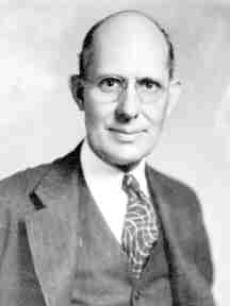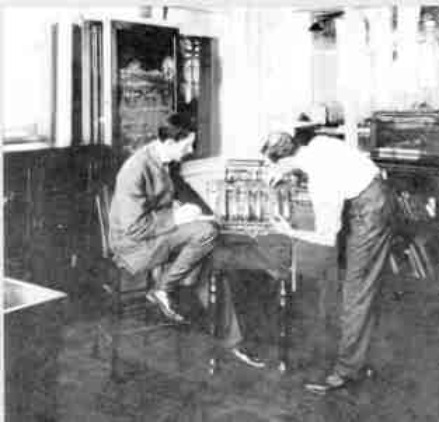- Home
- Introduction
- Website News
- Postscript Magazines
- British History
- Company History
- British History National Cash Register Co. Ltd., 1896 - 1900
- NCR Films
- NCR Vintage Products
- Divisions
- NCR Newscast Tapes.
- Personalities
- The National Cash Register Company Ltd. 1896-1900
- Circuit News - Field Engineering
- Vintage Cash Register Service Aids2
- Supplies
Charles F. Kettering
In 1904 a bespectacled engineering graduate from The Ohio State University was hired by factory manager Edward A. Deeds on the advice of one of Deeds' former college professors. Charles F. Kettering had demonstrated a knack for "tinkering," as he called it, and was to join NCR's "Inventions 3 department."
Born on a Loudonville, Ohio, farm in 1876, Kettering had already conquered many problems by the time he came to NCR. Largely self-educated, he had to leave Ohio State for awhile until his eyesight improved enough to allow him to continue his studies. His interest in science developed while he was a grade school teacher as he experimented with photography and electricity.

By the time he reached NCR, he was a self-taught telephone installer, which made him a natural to develop the "O.K. Charge Phone," a system for verifying credit in department stores. His next project involved doing what many thought was impossible - electrifying the cash register. Deeds had insisted that it could be done, but the "experts" were certain that the project required a motor nearly as large as the cash register itself.
Approaching the problem with "a characteristic blank sheet of paper," Kettering and his crew soon saw that the problem was a matter of torque. What was needed was "a quick burst of power to drive the register's internal mechanism." The solution was a simple mechanical clutch and by 1906, the factory was flooded with orders for the new "crankless" register. the project required a motor nearly as large as the cash register
Kettering went on to develop the Class 1000 register, a low-cost, completely redesigned machine that remained in production, with minor changes, for more than 40 years. He also forever revolutionized the way NCR engineers tackled engineering problems through the use of thorough engineering studies, allowing the company to tool up faster when implementing new products.
In 1909, Kettering left the company to devote himself full-time to automotive inventions. Working with Deeds and others in a converted barn, he designed the first practical automobile self-starter, clearing the way for mass-market acceptance of the personal car. The association with Deeds led to the formation of Dayton Engineering Laboratories Company (Delco), which merged in 1916 with what would become General Motors.
Kettering went on to develop or assist in the development of countless other patents and inventions, including a portable electric generator, the ignition system for the Liberty aircraft engine, anti-knock or "ethyl" gasoline, better and more long-lasting automotive finishes, the non-toxic and non-flammable refrigerant Freon, air cooling for domestic refrigerators, and an improved diesel engine for use in trucks, cars, railroad engines and even submarines.

At work in the Inventions 3 Department 1905:-
A man of enormous compassion, Kettering co-founded the Sloan-Kettering Institute for Cancer Research, today one of the world's foremost institutions in the fight against cancer.
In 1927, he founded the Kettering Foundation, a research-oriented organization charged with answering such questions as "trying to find out why the grass is green."
Inventor, scientist, educator, businessman and philanthropist, Kettering returned to NCR in 1936 when he was elected to the company's board of directors. At the time, NCR's chief engineer noted that, "Even after 25 years, the influence of Charles F. Kettering's work is present in our product today more than that of any other single man."
A Dayton suburb now bears his name and Kettering's mark remains on the transportation industry throughout the world. His vision was always on tomorrow. As he said: "We should all be concerned about the future because we will have to spend the rest of our lives there."